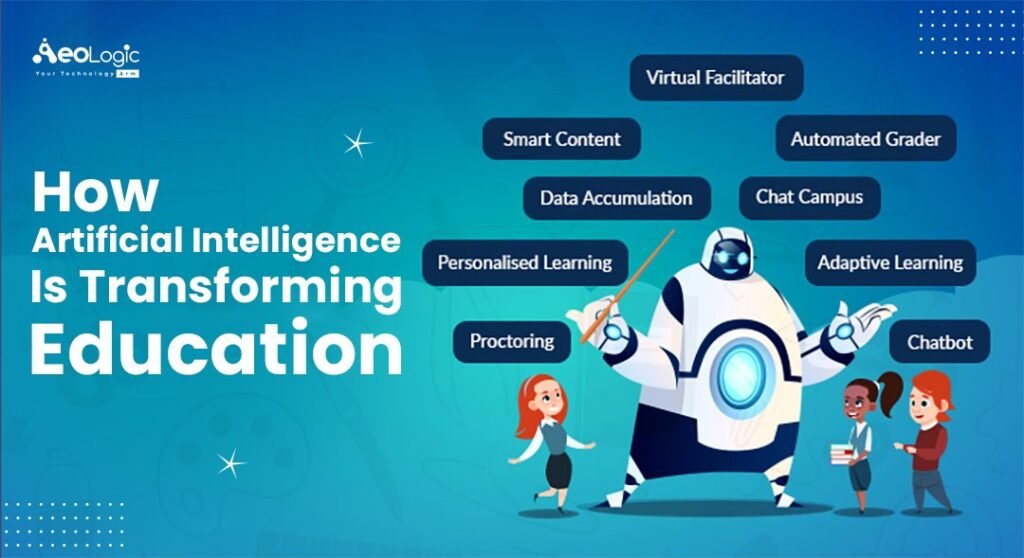How Technology is Transforming Education in the USA
Taming the Tech Tiger: How Technology is Transforming Education in the USA
The American classroom is no longer just a place of textbooks and blackboards. Technology has roared into the educational landscape, transforming the way students learn and teachers teach. From online learning platforms to educational apps and virtual reality tools, the “Tech Tiger” is here to stay. But with this exciting evolution comes a responsibility to harness its power responsibly and effectively.
This blog will explore the growing role of technology in classrooms across the USA. We’ll delve into the exciting possibilities offered by online platforms, educational apps, and virtual reality. We’ll also discuss the challenges that come with integrating technology and offer guidance for educators and parents on how to utilize it responsibly for optimal learning.
The Rise of the Tech Tiger: Exploring Educational Technology Tools
The Tech Tiger comes in a variety of stripes, each offering unique ways to enhance learning. Let’s explore some of the most prominent tools:
- Online Learning Platforms: These platforms provide a virtual space for learning, offering access to interactive courses, curriculum resources, and collaborative tools. Platforms like Schoology, Canvas, and Edmodo allow students to learn at their own pace, revisit materials, and connect with classmates and teachers remotely.
- Educational Apps: From language learning apps like Duolingo to science simulations like iSimulate, educational apps offer bite-sized, engaging learning experiences. They can be used to supplement classroom learning, provide targeted practice, and cater to diverse learning styles.
- Virtual Reality (VR): VR puts students right in the heart of the action, whether it’s dissecting a frog in biology class or exploring the Great Wall of China in history. VR offers immersive learning experiences that can enhance understanding and make abstract concepts more accessible.
- Augmented Reality (AR): AR overlays digital information on the real world, creating interactive experiences. Imagine students holding up a tablet to see the skeletal structure of a dinosaur come to life on their screen! AR apps like Google Expeditions and Quiver allow students to interact with learning materials in a whole new way.
- Gamification: Educational games make learning fun and engaging. Platforms like Kahoot! and Quizizz use game mechanics like points, badges, and leaderboards to turn quizzes and reviews into interactive challenges.
These are just a few examples, and the EdTech landscape continues to evolve rapidly. New tools and applications are constantly emerging, offering even more innovative ways to engage students.

Unleashing the Tiger’s Potential: Benefits of Educational Technology
Technology offers a multitude of benefits for both students and teachers:
- Personalized Learning: Educational technology allows teachers to tailor learning experiences to individual student needs. Online platforms can offer differentiated instruction with adaptive learning software that adjusts difficulty based on student performance.
- Increased Engagement: Interactive tools and games can capture student attention and make learning more enjoyable. This can be especially helpful for students who struggle with traditional methods.
- Accessibility and Flexibility: Online learning platforms and educational apps enable learning beyond the confines of the classroom. Students can access materials and complete assignments anytime, anywhere. This is particularly beneficial for students with disabilities or those who live in remote areas.
- Improved Collaboration: Online platforms and collaborative tools like Google Docs and Padlet allow students to work together on projects remotely, fostering teamwork and communication skills.
- 21st Century Skills Development: Educational technology helps students develop essential 21st-century skills such as digital literacy, critical thinking, problem-solving, and information technology (IT) skills, which are crucial for success in the modern workforce.
- Global Connectivity: Online platforms connect students with peers and educators from around the world, fostering cultural exchange and global awareness.
Taming the Tiger: Challenges in Implementing Educational Technology
While the benefits of educational technology are undeniable, there are also challenges to consider:
- Digital Divide: Not all students have equal access to technology or a reliable internet connection. This can create a digital divide, where some students are left behind in a tech-driven learning environment.
- Tech Integration Challenges: Integrating technology effectively into the curriculum requires time and planning from teachers. They need professional development opportunities to learn how to use these tools effectively.
- Screen Time Concerns: Excessive screen time can lead to health problems like eye strain and difficulty focusing. It’s important to find a balance between technology-based learning and traditional methods.
- Distractions and Misuse: Technology can be a source of distraction, especially if it’s not managed properly. Students might be tempted to use it for social media or games instead of learning.
- Cost: Implementing and maintaining educational technology tools can be expensive for schools. Funding needs to be allocated to ensure equitable access for all students.
Riding the Tech Tiger Together: Tips for Educators and Parents
Here are some tips for educators and parents on how to utilize educational technology responsibly and effectively:

Taming the Tech Tiger: How Technology is Transforming Education in the USA (Continued)
Educators:
- Focus on Integration, not Replacement: Don’t let technology replace tried-and-true teaching methods. Use it to enhance and support them. Technology should be a tool, not the sole driver of instruction.
- Prioritize Professional Development: Schools should invest in professional development opportunities to train teachers on how to effectively integrate technology into their lessons. This could include learning about various EdTech tools, creating engaging online content, and classroom management strategies in a tech-rich environment.
- Promote Digital Citizenship: Teach students about responsible digital citizenship. Discuss issues like cyberbullying, online safety, and ethical internet use.
- Balance Screen Time: Create a healthy balance between technology-based learning and traditional methods. Schedule breaks and encourage activities that don’t involve screens.
- Embrace the Collaborative Spirit: Utilize online platforms for collaborative learning projects. This allows students to connect with peers and educators beyond their classroom walls.
- Differentiate Instruction: Leverage educational technology to tailor learning experiences to individual student needs. Online platforms often offer adaptive learning tools that can personalize the curriculum based on student performance.
Parents:
- Stay Informed: Educate yourself about the different educational technology tools being used in your child’s classroom. Talk to their teachers and understand how they’re being implemented.
- Set Boundaries: Establish clear guidelines for screen time at home. Encourage your child to engage in other activities like reading, physical play, and face-to-face interactions.
- Open Communication: Talk to your child about their online experiences. Discuss responsible digital citizenship and online safety.
- Be a Learning Partner: Explore educational apps and online resources together with your child. This can be a great way to bond and reinforce the learning happening in the classroom.
- Advocate for Equity: If you’re concerned about the digital divide in your child’s school, get involved in discussions about ensuring equitable access to technology for all students.
The Future of Education: Riding the Tech Tiger Together
The Tech Tiger is a powerful force in education, and it’s not going anywhere. By embracing its potential while acknowledging its challenges, educators, parents, and students can work together to transform learning experiences for a new generation.
Technology can unlock a world of knowledge and ignite a passion for learning. But it’s crucial to utilize it responsibly, ensuring inclusivity, digital citizenship, and a healthy balance with traditional teaching methods. When we ride the Tech Tiger together, it can propel education to new heights, preparing students for a future filled with exciting possibilities.
Additional Resources:
- The National Center for Education Statistics: https://nces.ed.gov/
- The International Society for Technology in Education (ISTE): https://iste.org/
- Common Sense Media: https://www.commonsensemedia.org/
This blog post offers a comprehensive exploration of educational technology, from its potential benefits to its challenges. By providing resources for educators and parents, we can all work together to ensure that the Tech Tiger empowers, not hinders, the learning journey of every student.